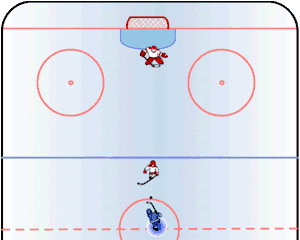Deke (ice hockey)
A deke feint or fake is an ice hockey technique whereby a player draws an opposing player out of position or is used to skate by an opponent while maintaining possession and control of the puck.[1] The term is a Canadianism formed by abbreviating the word decoy.[2]

| Look up deke in Wiktionary, the free dictionary. |
The position of the player performing the deke and the defender determines where the puck will be moved and the speed. The deke can be used to move the puck out of reach of an opposing player, move the puck past the opposing player, or quickly change direction of the puck so the opposing player is caught out of position. Dekes are usually used in combination with either a change of direction or speed, or both; the deke may refer to the entire sequence of actions as well as the maneuver(s) made with the stick. Often a change in direction or a change in speed is enough to get past an opposing player, but dekes are used in combination with these to better protect the puck and get by a defender.
Types
One type is the head fake, using a movement of the head to fool an opposing player over the player's movements or intention.[3]
Toe drag
A more complex deke is the toe drag, a deke in which the puck carrier brings the puck forward on their forehand, and subsequently turns their stick and pulls the puck towards themselves with the toe of the blade, while moving past the defender, who has presumably attempted to poke check the puck in its previous position.[4]
References
- Podnieks, Andrew (2007). The Complete Hockey Dictionary. Fenn Publishing. ISBN 978-1-55168-309-6.CS1 maint: ref=harv (link)
- Podnieks 2007, p. 54.
- http://www.merriam-webster.com/dictionary/deke
- Podnieks 2007, p. 96.
- Swope, Bob (2010). Youth Ice Hockey Drills, Plays, and Games Handbook. Jocabob Press. p. 54. Retrieved 2016-03-29.